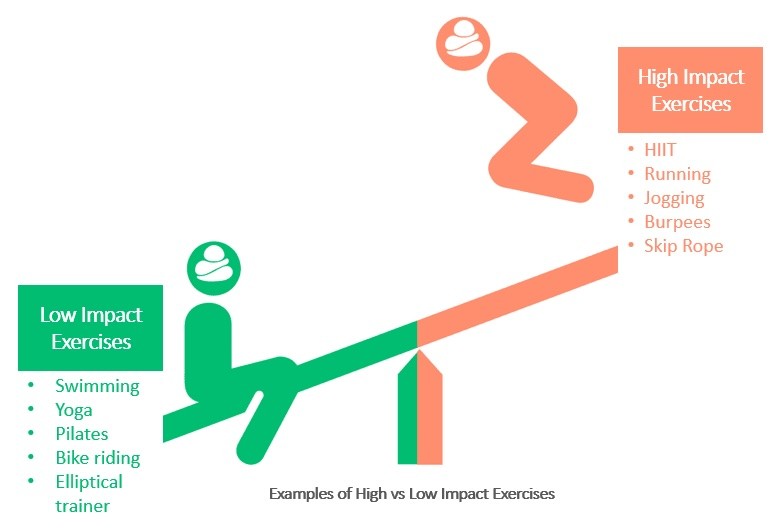Staying active is key to a healthy lifestyle, but the type of exercise, such as low-impact cardio or high-impact activities, can significantly affect your joint health. Let’s dive into the differences between low-impact exercises and high-impact sports to help you make informed choices that benefit your body while protecting your joints.
Low-Impact Exercises: Gentle Yet Effective
Low-impact exercises are ideal for those looking to stay active without stressing their joints. These activities include walking, cycling, swimming, and using a pedal exerciser. They offer numerous benefits, especially for those with joint issues or arthritis.
Benefits of Low-Impact Exercises
Low-impact exercises are not just gentle on the joints; they offer a range of benefits that are particularly advantageous for seniors and individuals with joint concerns.
Joint Health Protection: Low-impact exercises like swimming, cycling, and walking minimize the impact on your joints. This is crucial for seniors, as it helps prevent the exacerbation of conditions like osteoarthritis and reduces the risk of joint inflammation and joint pain. By avoiding high-impact stress, these activities allow you to stay active without aggravating existing joint health issues.
Improved Cardiovascular Health: Despite their gentle nature, low-impact exercises are effective in boosting cardiovascular health. Activities like brisk walking or cycling enhance heart and lung function, which is essential for overall health, particularly as you age. This improved cardiovascular fitness can lead to better endurance and energy levels, enhancing overall joint health.
Enhanced Mobility and Flexibility: Regular participation in low-impact exercises promotes better joint health, mobility, and flexibility. Swimming, for example, offers a full-body workout that helps maintain and improve range of motion, which is vital for maintaining independence and quality of life in seniors.
Safe for All Fitness Levels: These low-impact exercises are easily adjustable to different fitness levels and abilities. Whether you're new to exercise or have been active for years, low-impact exercises can be tailored to suit your needs, making them a versatile option for maintaining physical fitness.
High-Impact Sports: High Reward with High Risk
High-impact sports, such as running, basketball, and aerobics, involve more intense movements that put additional stress on your joint health. While these activities can significantly boost cardiovascular fitness, muscle strength, and bone density, they also come with a higher risk of joint pain and injuries.
Benefits and Risks of High-Impact Sports
High-impact sports can be highly beneficial but also come with potential risks that need to be managed carefully, especially for older adults.
Benefits:
Cardiovascular Boost: High-impact activities like running and basketball significantly improve cardiovascular health by elevating the heart rate and increasing stamina. This can be particularly beneficial for maintaining joint health, cardiovascular health, and overall fitness.
Muscle and Bone Strength: These activities contribute to stronger muscles and bones, which can help with balance and reduce the risk of falls, a common concern for seniors, thereby supporting joint health.
Risks:
Injury Risk: The intense movements in high-impact sports put extra stress on joints, which can lead to injuries such as sprains, fractures, and overuse syndromes. For individuals with pre-existing joint conditions, the risk of exacerbating these issues is higher.
Recovery Time: The recovery time from high-impact injuries can be longer, and the risk of chronic joint pain and other problems increases with repeated stress. This makes it crucial to approach these activities with caution and to incorporate appropriate recovery strategies.
Finding the Right Balance
The key to a well-rounded fitness routine is balance. Combining low-impact exercises with occasional high-impact sports can provide a comprehensive approach to health. For instance, regular low-impact exercises can maintain joint health and overall fitness, while integrating high-impact activities can enhance cardiovascular and muscular strength.
Tips for Joint Health
Maintaining joint health is essential for enjoying an active lifestyle. Here’s why each tip is important:
Warm-Up and Cool-Down:
Warm-Up: Preparing your body with a warm-up increases blood flow to the muscles and joints, which helps them become more flexible and less prone to injury. A proper warm-up also prepares your cardiovascular system for exercise, reducing the risk of strains and sprains.
Cool-Down: Cooling down helps your body gradually return to its resting state, allowing your heart rate and blood pressure to normalize. This process helps prevent stiffness and joint pain by promoting better circulation and aiding in the removal of metabolic waste products from the muscles.
Listen to Your Body: Paying attention to your body’s signals is crucial for avoiding injuries and protecting your joint health. If you experience joint pain or discomfort, it’s a sign that you may need to adjust your exercise routine or seek medical advice. Ignoring these signals can lead to more severe issues and hinder your ability to stay active.
Strength Training: Strength training exercises, such as lifting light weights or using resistance bands, help build muscle around the joints to support joint health. This added muscle support improves joint stability and reduces the likelihood of injuries. It’s particularly beneficial for maintaining joint health and overall physical function as you age.
Hydration and Nutrition: Proper hydration and a balanced diet are vital for joint health. Nutrients such as omega-3 fatty acids (found in fish), calcium (found in dairy products), and vitamin D (from sunlight and fortified foods) support joint lubrication and bone health. Staying hydrated also helps keep joints lubricated and functioning smoothly, reducing the risk of stiffness and joint pain.
By understanding the differences between low-impact exercises and high-impact exercises, you can tailor your fitness routine to include a mix of both. This approach allows you to enjoy a healthy, active lifestyle while safeguarding your joint health. For more information and support on low-impact exercise options, explore the resources available on nobol.com. Stay active, stay informed, and keep your joints happy and healthy!

